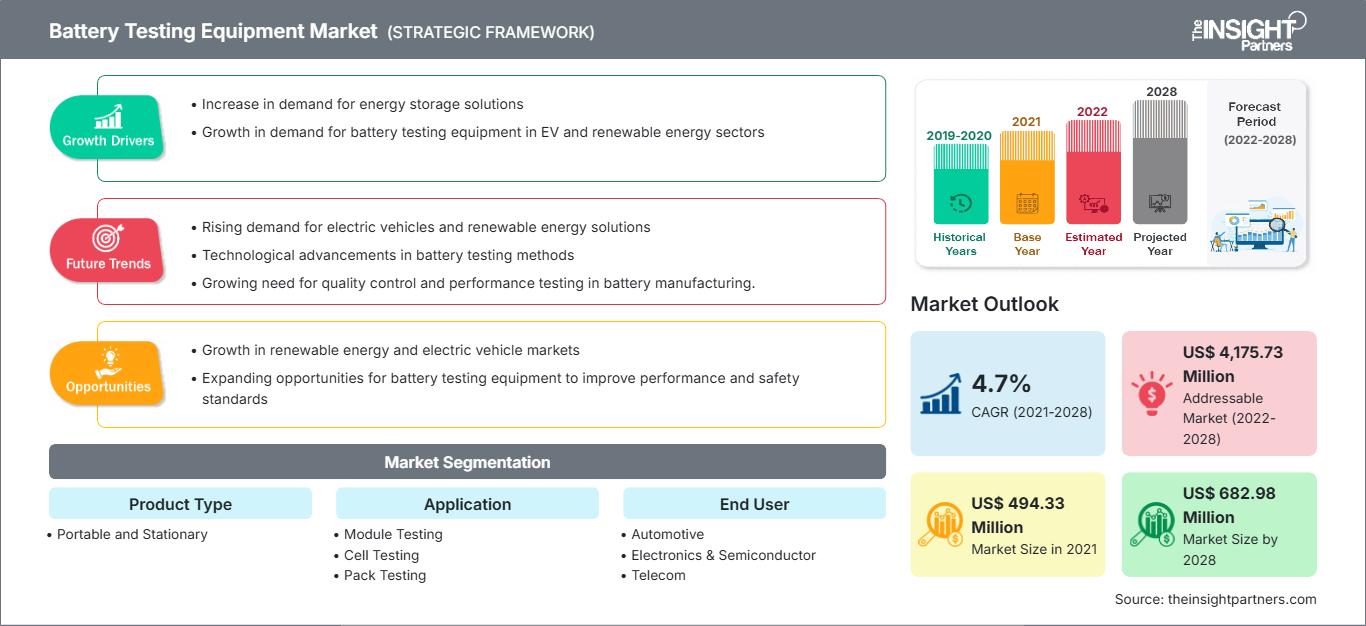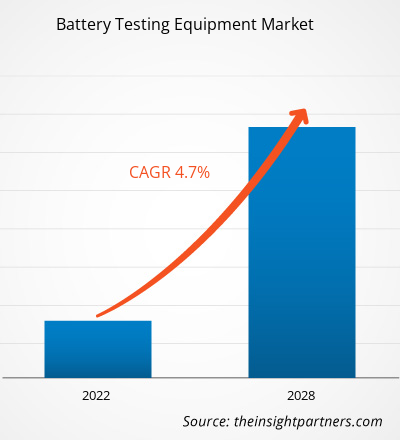Der Markt für Batterietestgeräte wurde im Jahr 2021 auf 494,33 Millionen US-Dollar geschätzt und soll bis 2028 voraussichtlich 682,98 Millionen US-Dollar erreichen; von 2021 bis 2028 wird ein durchschnittliches jährliches Wachstum von 4,7 % erwartet.
Branchen wie die Luft- und Raumfahrt- und Verteidigungsindustrie, die Automobilindustrie und das Gesundheitswesen investieren massiv in fortschrittliche Technologien, um ihre Kapazitäten mit modernen Maschinen zu stärken und ihren Kunden verbesserte Dienstleistungen anzubieten. Unternehmen in den USA, Frankreich, Schweden, Großbritannien und anderen Ländern entwickeln fortschrittliche Batterietestgeräte für ihre weltweiten Kunden. Die steigende Beschaffung fortschrittlicher Batterien durch die US-Armee unterstützt das Marktwachstum ebenfalls. Darüber hinaus dürften die Entwicklung von eVTOLs und Initiativen von Regierungen in Ländern wie Deutschland, den Vereinigten Arabischen Emiraten und Singapur zum Ausbau der städtischen Luftmobilitätsinfrastruktur das Wachstum der Akteure auf dem Markt für Batterietestgeräte vorantreiben.
Erhöhte Verteidigungsausgaben in Ländern wie den USA, China, Indien und anderen dürften das Wachstum des Marktes für Batterietestgeräte in den kommenden Jahren vorantreiben. Entwicklungsländer wie Indien, China und Indonesien konzentrieren sich aufgrund zunehmender grenzüberschreitender Konflikte auf die Stärkung ihrer militärischen Fähigkeiten. Die expandierenden Fertigungssektoren in Ländern wie China und Indien treiben das Wachstum des Marktes für Batterietestgeräte weiter voran.
Passen Sie diesen Bericht Ihren Anforderungen an
Sie erhalten kostenlos Anpassungen an jedem Bericht, einschließlich Teilen dieses Berichts oder einer Analyse auf Länderebene, eines Excel-Datenpakets sowie tolle Angebote und Rabatte für Start-ups und Universitäten.
Markt für Batterietestgeräte: Strategische Einblicke

-
Holen Sie sich die wichtigsten Markttrends aus diesem Bericht.Dieses KOSTENLOSE Beispiel umfasst Datenanalysen, die von Markttrends bis hin zu Schätzungen und Prognosen reichen.
Auswirkungen der COVID-19-Pandemie auf das Marktwachstum von Batterietestgeräten in Nordamerika
Die USA sind das am stärksten von COVID-19 betroffene Land in Nordamerika. Viele Produktionsstätten wurden entweder vorübergehend geschlossen oder arbeiten mit minimaler Besetzung; die Lieferkette für Komponenten und Teile ist unterbrochen; dies sind einige der kritischen Probleme, mit denen die nordamerikanischen Hersteller konfrontiert sind.
Da es in den USA eine größere Anzahl von Batterietestgeräten, Komponentenherstellern und Industrien gibt, hat der Ausbruch jede einzelne Produktion und jeden Umsatz stark beeinträchtigt. Die geringere Anzahl an Produktionsmitarbeitern hat zu geringeren Produktionsmengen geführt. Andererseits haben die begrenzte Verfügbarkeit von Rohstoffen und die Schließung von Luft- und Raumfahrtbetrieben auch den Markt für Batterietestgeräte in den USA beeinflusst. Die steigenden Militärausgaben des Landes und die zunehmende Entwicklung von Elektrofahrzeugen durch Unternehmen wie Tesla dürften den Akteuren auf dem Markt für Batterietestgeräte in naher Zukunft jedoch Wachstumschancen bieten.
Markteinblicke – Markt für Batterietestgeräte
Wachsende Nachfrage nach Transportmitteln treibt den
Aufgrund des steigenden verfügbaren Einkommens der Menschen in Entwicklungsländern wie China, Indien, Südkorea und anderen ist die Nachfrage nach Fahrzeugen gestiegen. Laut der Society of Indian Automobile Manufacturers (SIAM) stiegen die Pkw-Verkäufe in Indien von September 2019 bis September 2020 um 26,45 %. Faktoren wie steigende Investitionen namhafter Fahrzeughersteller und günstige staatliche Normen für die Fahrzeugherstellung im gesamten asiatisch-pazifischen Raum dürften das Wachstum des Marktes für Batterietestgeräte in der Region vorantreiben. Darüber hinaus dürften Initiativen der Regierungen von Ländern wie Vietnam zum Ausbau ihrer Automobilindustrie das Marktvolumen für Batterietestgeräte ebenfalls steigern.
Produkttypbasierte Erkenntnisse
Basierend auf dem Produkttyp ist der Markt für Batterietestgeräte in tragbare und stationäre Batterietestgeräte segmentiert. Das Segment der stationären Batterieprüfgeräte war mit einem Marktanteil von 54,1 % im Jahr 2020 Marktführer auf dem Markt für Batterieprüfgeräte. Die stationären Batterietests werden für einen Kapazitätstest durchgeführt, wenn die Batterie im Rahmen der Abnahmeprüfung neu ist, für Impedanztests, um Basiswerte für die Batterie festzulegen, und um den oben genannten Testvorgang innerhalb von zwei Jahren zur Gewährleistung der Batterie zu wiederholen. Der Testprozess prüft die Impedanz von ventilgeregelten Blei-Säure-Zellen (VRLA) vierteljährlich und führt alle 25 % der erwarteten Lebensdauer Kapazitätstests durch.
Anwendungsbasierte Erkenntnisse
Basierend auf der Anwendung ist der Markt für Batterieprüfgeräte in Modultests, Zelltests und Packtests segmentiert. Das Segment Zelltests war 2020 Marktführer. Die Zellbelastungstests werden durchgeführt, um unter anderem die Reaktion auf elektrische, umweltbedingte und mechanische Belastungen zu bewerten. Zelltests sorgen für eine lange Batterielebensdauer und simulieren komplexe, reale Testprofile. Darüber hinaus sind Zelltester für die Durchführung von Tests an Lithium-Ionen-Batterien, elektrischen Doppelschichtkondensatoren (EDLC) und Lithium-Ionen-Kondensatoren (LIC) konzipiert. Dies dürfte den Markt für Batterietestgeräte vergrößern.
Geografisch ist der Markt für Batterietestgeräte in fünf Hauptregionen unterteilt: Nordamerika, Europa, APAC, MEA und SAM. Im Jahr 2020 hatte Nordamerika den größten Umsatzanteil, gefolgt von Europa und APAC. Der Markt in APAC wird voraussichtlich von 2020 bis 2028 mit 5,8 % das schnellste CAGR-Wachstum verzeichnen. Arbin Instruments, Century Yuasa Batteries Pty Ltd., Chauvin Arnoux, Chroma Systems Solutions, Inc., DV Power, Extech Instruments, Megger, Midtronics, Inc., Storage Battery Systems, LLC und Xiamen Tmax Battery Equipments Limited gehören zu den wichtigsten Akteuren des Ökosystems, die in dieser Marktstudie profiliert wurden.
Batterietestgeräte
Regionale Einblicke in den Markt für BatterietestgeräteDie Analysten von The Insight Partners haben die regionalen Trends und Faktoren, die den Markt für Batterieprüfgeräte im Prognosezeitraum beeinflussen, ausführlich erläutert. In diesem Abschnitt werden auch die Marktsegmente und die geografische Lage von Batterieprüfgeräten in Nordamerika, Europa, im asiatisch-pazifischen Raum, im Nahen Osten und Afrika sowie in Süd- und Mittelamerika erörtert.
Umfang des Marktberichts zu Batterietestgeräten
| Berichtsattribut | Einzelheiten |
|---|---|
| Marktgröße in 2021 | US$ 494.33 Million |
| Marktgröße nach 2028 | US$ 682.98 Million |
| Globale CAGR (2021 - 2028) | 4.7% |
| Historische Daten | 2019-2020 |
| Prognosezeitraum | 2022-2028 |
| Abgedeckte Segmente |
By Produkttyp
|
| Abgedeckte Regionen und Länder |
Nordamerika
|
| Marktführer und wichtige Unternehmensprofile |
|
Dichte der Marktteilnehmer für Batterietestgeräte: Auswirkungen auf die Geschäftsdynamik verstehen
Der Markt für Batterietestgeräte wächst rasant. Die steigende Nachfrage der Endverbraucher ist auf Faktoren wie veränderte Verbraucherpräferenzen, technologische Fortschritte und ein stärkeres Bewusstsein für die Produktvorteile zurückzuführen. Mit der steigenden Nachfrage erweitern Unternehmen ihr Angebot, entwickeln Innovationen, um den Bedürfnissen der Verbraucher gerecht zu werden, und nutzen neue Trends, was das Marktwachstum weiter ankurbelt.

- Holen Sie sich die Markt für Batterietestgeräte Übersicht der wichtigsten Akteure
Akteure auf dem Markt für Batterietestgeräte konzentrieren sich hauptsächlich auf die Entwicklung fortschrittlicher und effizienter Produkte und Kooperationen.
- Im Jahr 2021 arbeiteten Keysight Technologies, Inc. und Proventia Oy zusammen, um Testlösungen für Batterien von Elektrofahrzeugen (EV) zu verbessern.
- Chroma brachte 2021 ein Schnellladetestsystem für E-Scooter auf den Markt, um die CHAdeMO Association bei der Überprüfung von Ladeschnittstellenstimulatoren für Elektrofahrzeuge zu unterstützen. Im Einklang mit dem internationalen Wachstum der EV-Branche wird es auch dazu beitragen, das Protokoll-Checksheet für Schnellladeteststandards für zweirädrige Elektrofahrzeuge zu definieren.
- Historische Analyse (2 Jahre), Basisjahr, Prognose (7 Jahre) mit CAGR
- PEST- und SWOT-Analyse
- Marktgröße Wert/Volumen – Global, Regional, Land
- Branchen- und Wettbewerbslandschaft
- Excel-Datensatz
Aktuelle Berichte
Verwandte Berichte
Erfahrungsberichte
Grund zum Kauf
- Fundierte Entscheidungsfindung
- Marktdynamik verstehen
- Wettbewerbsanalyse
- Kundeneinblicke
- Marktprognosen
- Risikominimierung
- Strategische Planung
- Investitionsbegründung
- Identifizierung neuer Märkte
- Verbesserung von Marketingstrategien
- Steigerung der Betriebseffizienz
- Anpassung an regulatorische Trends






















 Kostenlose Probe anfordern für - Markt für Batterietestgeräte
Kostenlose Probe anfordern für - Markt für Batterietestgeräte